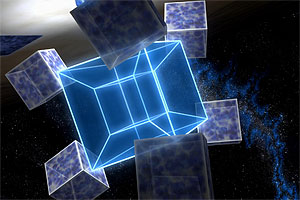
Sitting in a small, non-descript room in the basement of the Lawrence Berkeley National Lab in Berkeley, physics graduate student Hannah Swift and physicist Saul Perlmutter are searching for supernovae, stars destroyed in huge explosions millions or billions of years ago. (They're looking for ones that exploded billions of years ago). Through a computer hooked up to Hawaii's Keck 2 telescope -– one of the largest in the world –- they are able to follow along as UC Berkeley post-doc Rahman Amanullah, a team member who had traveled to Hawaii a few days earlier, supervises the night's observation.
Their goal is to use a device called a spectrograph to get a spectra of five to eight supernovae. This spectrum is a "photograph" of the light emitted by the supernova and it allows scientists to determine whether they are the type Ia supernovae that are useful for their research. By figuring out how far away these type Ia supernovae are (or "were," since by the time their light reaches us, they have long since vanished) and observing how much the light traveling towards the Earth has shifted towards red wavelengths, they can determine how long ago the star exploded. With this information, they're building a history of the expansion of the universe. The weather in Hawaii is good, and the researchers are forecasting a good "seeing."
It's encouraging and moving to see how young these researchers are. Swift is a twenty-something from Kansas. She's so young that she has always understood the universe to be accelerating, that is, expanding faster and faster. She has never thought that the universe is decelerating, which is what the scientific community believed before 1998, when Perlmutter's team at Lawrence Berkeley National Lab and another team simultaneously reported their findings that the universe is accelerating. When this announcement was made, Swift was in the 8th grade. Perlmutter himself is only in his 40s. When he started his post-doc, he and his colleagues had to beg for time on the big telescopes. That wasn't that long ago: our understanding of the universe has shifted very fast.
A few days later, Swift invites us back to the lab to show us some of the data the researchers gathered during the observation. They obtained spectra for five supernovae – a good night's work. Swift is now in the process of figuring out which of the supernovae are type Ia's. To do this, she's comparing their spectrograms to the spectra of a standard type Ia. Light is a very useful tool because different elements emit light of different wavelengths. Swift shows me the spectrogram for a standard type Ia. It has telltale peaks and valleys that reveal what exploding type Ia supernovae eject when they explode – silicon and cobalt, among other elements.